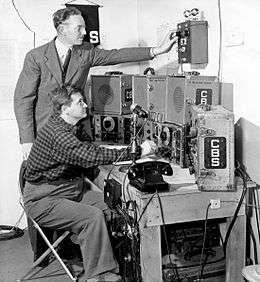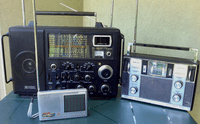Shortwave listening

Shortwave listening, or SWLing, is the hobby of listening to shortwave radio broadcasts located on frequencies between 1700 kHz and 30 MHz.[1] Listeners range from casual users seeking international news and entertainment programming, to hobbyists immersed in the technical aspects of radio reception and collecting official confirmations (QSL cards) that document their reception of distant broadcasts (DXing). In some developing countries, shortwave listening enables remote communities to obtain regional programming traditionally provided by local medium wave AM broadcasters. One 2002 estimate placed the number of shortwave listeners worldwide in the hundreds of millions.
The practice of long-distance radio listening began in the 1920s when shortwave broadcasters were first established in the US and Europe. Audiences discovered that international programming was available on the shortwave bands of many consumer radio receivers, and a number of magazines and listener clubs catering to the practice arose as a result. Shortwave listening was especially popular during times of international conflict such as World War II, the Korean War and the Persian Gulf War.
Listeners use inexpensive portable "world band" radio receivers to access the shortwave bands, and some advanced hobbyists employ specialized communications receivers featuring digital technology designed for optimum reception of shortwave signals, along with outdoor antennas to enhance performance.
With the advent of the internet, many international broadcasters have scaled back or terminated their shortwave transmissions in favor of web-based program distribution, while others are moving from traditional analog to digital broadcasting modes in order to allow more efficient delivery of shortwave programming. The number of organized shortwave listening clubs has diminished along with printed magazines devoted to the hobby; however, many enthusiasts continue to exchange information and news on the web.
History
The practice of listening to distant stations in the medium wave AM broadcast band was carried over to the shortwave bands. Frank Conrad, an early pioneer of medium wave broadcasting with KDKA in Pittsburgh, instituted some of the first shortwave broadcasts around 1921. Stations affiliated with General Electric and Crosley followed shortly after.

United States shortwave broadcasters began transmitting popular radio programs in an attempt to attract foreign audiences. During the 1930s, new shortwave receivers appeared on the market as well as popular shortwave magazines and clubs. Shortwave stations often offered unique QSL cards for DXers.
In Europe, shortwave broadcasts from Britain and the Netherlands such as Philips Radio's PCJJ began around 1927. Germany, Italy, the Soviet Union, Britain, and many other countries soon followed, and some classic shortwave broadcasters got their start. The BBC began on shortwave as the "BBC Empire Service" in 1932.[2] Its broadcasts were aimed principally at English speakers. Radio Moscow was broadcasting on shortwave in English, French, German, Italian and Arabic by 1939. The Voice of America (or VOA) began broadcasting in 1942 after its entry into World War II using the Yankee Doodle musical theme.
While technically minded shortwave listening hobbyists dwindled during the war years due in part to the demands of military service, casual listeners seeking war news from foreign broadcasters increased. Shortwave receiver manufacturers contributed to war production. Zenith launched the multi-band Trans-Oceanic series of radios in 1942. In some other countries, during the war, listening to foreign stations was a criminal offense. Established in 1939, 35-kilowatt Chinese shortwave station XGOY broadcast programming aimed at listening-restricted Japan. The station was often bombed by the Japanese.[3][4]

CBS began a shortwave listening program in September 1939, on an experimental basis, at the National Lawn Tennis Championships at West Side Tennis Club in Forest Hills, New York. Engineers installed equipment at the CBS booth when the location was found to have good reception, and monitors relayed European shortwave news to CBS headquarters in New York between tennis matches.[5] Throughout World War II, CBS captured Allied and enemy shortwave communications from more than 60 international stations via secretly located receivers. Translations of intercepted broadcasts were teletyped to all New York newspapers, Associated Press, United Press International and International News Service, and in turn disseminated to newspapers and radio stations throughout the United States. Major headline news frequently resulted, since big stories often broke first on radio.[6]
Shortwave listeners notified families of prisoners of war when studio announcers at stations in Axis powers countries, such as Germany and Japan, read prisoner-written messages. Allied monitors notified families, but many shortwave listeners were often first to report the broadcasts. Listeners in other countries also monitored POW messages.[7] Americans were actively discouraged from listening to these reports, however, since broadcasting the names of a few American prisoners was regarded as a propaganda trick to build up the listening audience for Axis radio programs. In May 1943 Jack Gerber, director of the CBS listening post, told journalist William L. Shirer that the International Red Cross was the only reliable source of information on prisoners, and expressed concern at receiving six or seven letters a week requesting transcripts of German broadcasts in which service members may have been mentioned:
The only reason the Nazis put on prisoner broadcasts is to get people justifiably anxious about relatives reported missing at the front to listen to their propaganda. Although many of the messages undoubtedly are true, they represent but a small fraction of our prisoners and we have no assurance that many of them are not faked from papers picked up on the battlefield. What concerns some of us is the consequences of listening to Nazi broadcasts unless you are a well-trained listener (and often, even if you are). Nazi arguments often sound plausible. A person may listen to them with all the skepticism in the world, knowing that every word is a lie. But if the content is sufficiently sensational (and it often is) the source may be forgotten in time, and out pops the Nazi lie, all unsuspecting.[8]
New Zealand shortwave listeners reported POW voices broadcast over Radio Peking during the Korean War.[7]
In the 1950s and 60s, shortwave DX columns in US magazines such as Popular Electronics′ "Tuning the Short Wave Bands" and Electronics Illustrated′s "The Listener" became news sources for serious radio listeners. Popular Electronics′ "WPE Monitor Registration" program, begun in 1959, even offered callsign-like identifiers to hobbyists. A number of specialty radio clubs such as the Newark News Radio Club also arose during these decades and provided hobbyists with an exchange of DX news and information. When Popular Electronics and similar magazines expanded coverage of new electronics topics in the 1970s, this led to the cancellation of several long-time shortwave listening columns.[9]
Beginning with Sweden Calling DXers on Radio Sweden in 1948[10] (there was a slightly earlier short-lived program from Radio Australia), many shortwave radio stations began programs providing news. Some of the other prominent DX programs were Radio Netherlands' DX Jukebox (which became Media Network), the SWL Digest on Radio Canada International, and the Swiss Shortwave Merry-go-round on Swiss Radio International.
An example of notable shortwave programming was the Happy Station Show, popularly called the “world’s longest-running shortwave radio program”. The show originated on Philips Radio's PCJJ shortwave station in 1928, continuing until 1940. After World War II Radio Netherlands broadcast the show from 1946 until it terminated in 1995. Producer and presenter Keith Perron “resurrected” Happy Station on March 12, 2009. Although no longer associated with Radio Netherlands, the new effort proclaims itself as “transmitted globally via shortwave, podcasting and Internet streaming radio”.[11]
During the Persian Gulf War in the 1990s, many Americans tuned into foreign news broadcasts on shortwave. Some electronics retailers even reported a "run" on portable shortwave receivers due to the increased interest at the time.[12]
Practices
Listening to shortwave broadcast stations for news and information programming is common, but for many shortwave listeners (abbreviated as "SWLs"), the goal is to receive as many stations from as many countries as possible, also known as DXing. "DXers" routinely test the limits of their antenna systems, radios and radio propagation knowledge. Specialized interests of shortwave listeners may include listening for shortwave utility, or "ute", transmissions such as shipping, sailing, naval, aviation, or military signals, listening for intelligence signals (numbers stations), or tuning in amateur radio stations.[1]

Listeners often obtain QSL cards (which confirm contact) from ham operators, broadcasters or utility stations as trophies of the hobby. Traditionally, listeners would send letters to the station with reception reports and requests for schedules. Many stations now accept E-mails or provide reception report forms on their Web sites. Reception reports give valuable information about propagation and interference to a station's engineers.[1]
There have been several publications dedicated to providing information to shortwave listeners, including the magazines Popular Communications (now a "digital supplement" to CQ Amateur Radio magazine), Monitoring Times (now defunct), and The Spectrum Monitor, a digital-only publication, in the United States, and the annual publications Passport to World Band Radio (now defunct) and the World Radio TV Handbook (WRTH). In addition, stations can provide broadcast schedules through the mail or E-mail. There are also shortwave radio programs dedicated to shortwave listening and DXing, such as the U.S.-based World of Radio and DXing With Cumbre, but recently these programs have been curtailed or dropped by many international broadcasters. As of 2007, Radio Habana Cuba still hosts a program called DXers Unlimited.
There are estimated to be millions of shortwave listeners. In 2002, according to the National Association Of Shortwave Broadcasters, for estimated numbers of households with at least one shortwave set in working order, Asia led with a large majority, followed by Europe, Sub Saharan Africa, and the former Soviet Union, respectively. The total estimated number of households worldwide with at least one shortwave set in working order was said to be 600,000,000.[13] SWLs are varied, with no common age or occupation. David Letterman is an admitted fan of the British Broadcasting Corporation (BBC).[1]
Some developing countries use shortwave as a means of receiving local and regional programming. China and Russia retransmits some domestic channels on shortwave that target listeners in far off provinces. Shortwave listening is also used as an educational tool in classrooms.[14] Poor sound reproduction, unreliable signal quality, and inflexibility of access are seen as disadvantages.[15]
Some humanitarian organizations like Ears to Our World distribute portable, self-powered shortwave radios to less developed parts of the globe, enabling people in remote, impoverished parts of the world to get educational programming, local and international news, emergency information and music. Recently, the group was involved in sending radios to Haiti so victims of the 2010 Haiti earthquake could stay abreast of local disaster recovery efforts.[11]
Equipment
Shortwave radio receivers
Radios for shortwave reception generally have higher performance than those intended for the local AM or FM broadcast band, since dependable reception of shortwave signals requires a radio with increased sensitivity, selectivity, and stability. Modern shortwave radio receivers are relatively inexpensive and easily accessible, and many hobbyists use portable "world band" receivers and built-in telescopic antennas.
Serious hobbyists may use expensive communications receivers and outdoor antenna located away from electrical noise sources, such as a dipole made from wire and insulators.
Features typical of modern solid state communications receivers:
- 500 kHz to 30 MHz frequency coverage
- Superheterodyne type - double, triple or quad conversion
- Multiple RF and IF stages
- A crystal controlled IF stage
- BFO product detector for SSB and CW reception
- Signal strength meter
- RF gain control; AVC/AGC adjustments
- Antenna tuner
- Bandwidth filters
- BFO tuning; audio limiters or attenuators.
- Frequency display dials - analog or digital.[16]

Older vacuum tube-based communications receivers are affectionately known as boatanchors for their large size and weight. Such receivers include the Collins R-390 and R-390A, the RCA AR-88, the Racal RA-17L and the Marconi Elettra. However, even modern solid-state receivers can be very large and heavy, such as the Plessey PR2250, the Redifon R551 or the Rohde & Schwarz EK070.[17]
A feature coming into wide use in modern shortwave receivers is DSP technology, short for digital signal processing. DSP is the use of digital means to process signals, and a primary benefit in shortwave receivers is the ability to tailor the bandwidth of the receiver to current reception conditions and to the type of signal being listened to. A typical analog-only receiver may have a limited number of fixed bandwidths, or only one, but a DSP receiver may have 40 or more individually selectable filters.[18]
Another important trend in modern shortwave listening is the use of "PC radios", or radios that are designed to be controlled by a standard personal computer. These radios as the name suggests are controlled by specialized PC software using a serial port connected to the radio. A PC radio may not have a front-panel at all, and may be designed exclusively for computer control, which reduces cost. In pure software defined radios, all filtering, modulation and signal manipulation is done in software, usually by a PC soundcard or by a dedicated piece of DSP hardware.[19]
Future of shortwave listening
The rise of the internet influenced many broadcasters to cease their shortwave transmissions in favor of broadcasting over the world wide web. When BBC World Service discontinued service to Europe, North America, Australasia, and the Caribbean, it generated many protests and activist groups such as the Coalition to Save the BBC World Service.[20] In the US, the shifting of resources from shortwave to Internet and television by the Broadcasting Board of Governors, which oversees U.S. international broadcasting, has also resulted in reduced broadcasting hours in the English language. Although most of the prominent broadcasters continue to scale back their analog shortwave transmissions or completely terminate them, shortwave is still very common and active in developing regions such as parts of Africa.
Some international broadcasters have turned to a digital mode of broadcasting called Digital Radio Mondiale for their shortwave outlets. One reason is that digital shortwave broadcasts using DRM can cover the same geographic region with much less transmitter power — roughly one-fifth the power — than traditional AM mode broadcasts, significantly reducing the electricity cost of operating a station. A traditional AM (analog) international shortwave station can have a power rating of 50 kilowatts to as much as one million watts per transmitter, with typical power levels in the 50–500 kilowatt range. Endorsed by the ITU, it has been approved as an international standard for digital broadcasts on the HF (shortwave) bands. A DRM broadcast rivals FM mono quality and can also send graphic images and web pages via a separate information channel.[21]
Shortwave listening also remains popular with some expatriates who tune in shortwave transmissions from their homeland. Additionally, a number of remotely controlled shortwave receivers located around the world are available to users on the web.[22] While radio hobbyists report that the number of shortwave listening clubs has diminished and printed magazines devoted to the hobby are few, enthusiasts such as Glenn Hauser and others continue to populate web sites, and originate podcasts dedicated to the pursuit.[23]
See also
- International broadcasting
- MW DX – Similar to SW DXing except on the MW (AM Radio) band
- List of American shortwave broadcasters
- World War II Radio Heroes: Letters of Compassion
References
- 1 2 3 4 "Introduction To Shortwave Listening". DXing.com. Universal Radio Research. Retrieved 2007-11-21.
- ↑ Analysis: BBC's voice in Europe Jan Repa, BBC News Online: 25 October 2005
- ↑ China Speaks Japanese, Time Magazine, Dec. 28, 1942
- ↑ Jerome S. Berg (2007). On the Short Waves, 1923–1945: Broadcast Listening in the Pioneer Days of Radio. McFarland. pp. 234–. ISBN 978-0-7864-3029-1. Retrieved 30 September 2013.
- ↑ "Radio: Propaganda Pigeons." Time, September 7, 1942, pp. 65–66
- ↑ "24,000,000 'Stolen' Words Go to Library of Congress." The Christian Science Monitor, September 4, 1945
- 1 2 Berg, Jerome S. (2008). Listening on the Short Waves, 1945 to Today. McFarland.
- ↑ Shirer, William L., "The Propaganda Front". The Montana Standard, May 4, 1943
- ↑ On The Shortwaves, The "WPE" Monitor Registration Program
- ↑ "About Sweden Calling DXers - MediaScan/Sweden Calling DXers". Sverigesradio.se. 2001-07-17. Retrieved 2012-08-31.
- 1 2 Osterman, Fred. "Newsroom." DXing Newsroom. 2004. Universal Radio Research. 6 April 2010.
- ↑ Tuning Into The World Via Shortwave, New York Times, June 3, 1992.
- ↑ NATIONAL ASSOCIATION OF SHORTWAVE BROADCASTERS, Inc. October 2002
- ↑ Hawkins, Ralph G. (March 1989). "A learning experience via short wave radio". Tech Trends, Volume 34, Number 2. Retrieved 15 April 2010.
- ↑ Wipf, Joseph A. "Shortwave Radio and the Second Language Class." The Modern Language Journal. 68.1 (Spring 1984): 7–8. JSTOR. 3 March 2010.
- ↑ Passport To WorldBand Radio
- ↑ Osterman, Fred (1998). Shortwave Receivers Past & Present: Communications Receivers 1942–1997. Universal Radio Research, Reynoldsburg (USA).
- ↑ H. Ward Silver (1 June 2006). The ARRL Ham Radio License Manual: All You Need to Become an Amateur Radio Operator. Technician]. Level 1. American Radio Relay League. pp. 3–. ISBN 978-0-87259-963-5. Retrieved 7 May 2013.
- ↑ Ziff Davis, Inc. (19 January 1999). PC Mag. Ziff Davis, Inc. pp. 56–. ISSN 0888-8507. Retrieved 7 May 2013.
- ↑ Save the BBC World Service.
- ↑ Digital Radio Mondiale
- ↑ Petruzzellis, Thomas (2007). 22 Radio and Receiver Projects for the Evil Genius. McGraw-Hill Professional. ISBN 978-0-07-148929-4.
- ↑ van de Groenendaal, Hans (January 7, 2009). "Is there a future for shortwave listening as a hobby?". EE Publishers. Retrieved 20 April 2010.
Further reading
- World Radio TV Handbook WRTH, ISBN 3-87463-356-X.
- Passport to World Band Radio, www.passband.com, ISBN 0-914941-61-5 (2007 ed.) ISBN 978-0-914941-66-8 (2008 ed.) ISBN 978-0-914941-80-4 (2009 ed.)
- Jerome S. Berg (2008). Listening on the short waves, 1945 to today. McFarland. ISBN 0-7864-3996-3.
- Popular Communications monthly magazine published by CQ Communications.
- Monitoring Times -- Monthly publication has ceased, but Grove Enterprises in Brasstown NC maintains some features at its website.